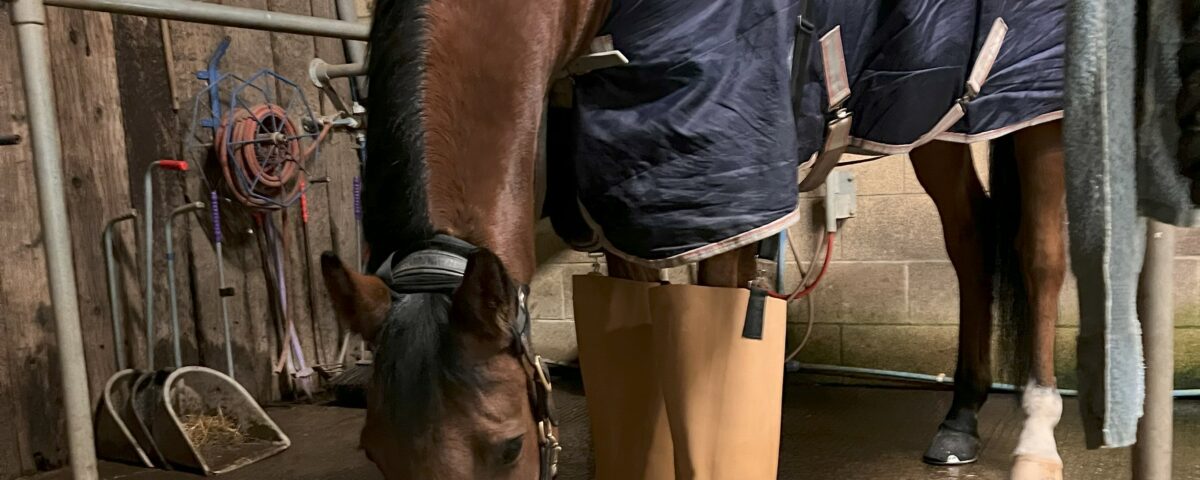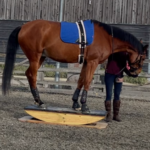
Wobble Board Training
November 21, 2023
New Wobble Boards
November 30, 2023In the world of equine sports and rehabilitation, the well-being of the horse is paramount. Just as human athletes use ice baths and cold packs to recover from intense training sessions, horses too can benefit from the therapeutic chill of cryotherapy. This age-old method with a modern twist is not just a trend; it’s a science-backed therapy that supports equine athletes in their recovery and overall health management. Here is a summary of the benefits of cryotherapy for horses:
Speeds Up Injury Recovery Injuries are an unfortunate part of athletic life, and horses are no exception. Cryotherapy works wonders by significantly reducing inflammation and swelling at the injury site. The cold constricts blood vessels, which decreases blood flow to the affected area, reducing the risk of tissue damage and speeding up the healing process.
Manages Pain Effectively The analgesic effect of cold therapy cannot be overlooked. By numbing nerve activity, cryotherapy helps in managing pain, providing horses with much-needed comfort following surgery or an acute injury. This non-invasive approach allows for a more natural method of pain relief, reducing the dependence on pharmaceuticals.
Prevents and Treats Laminitis Laminitis, a debilitating condition of the foot, has seen promising treatment results with cryotherapy. The early application of cold therapy can help prevent the progression of this disease by decreasing metabolic activity and inflammation, offering a ray of hope for affected equines.
Enhances Post-Workout Recovery Athletic horses often undergo rigorous training that can lead to muscle soreness and stiffness. Implementing cryotherapy post-exercise can decrease muscle fatigue and promote a quicker recovery, keeping your equine partner ready for the next day’s training or competition.
Reduces the Likelihood of Further Injury By addressing inflammation and pain immediately after it begins, cryotherapy helps to limit the extent of an injury. This proactive approach can reduce the duration of the rehabilitation period and prevent compensatory injuries that often occur from altered gait patterns.
What the research says
Research on cold therapy for horses, much like for humans, has shown it can be beneficial in various aspects of equine health and recovery. Studies typically focus on its efficacy in reducing inflammation, managing pain, and speeding up recovery from injuries or after intense exercise. Here are some key findings from research on cold therapy for horses:
Inflammation Reduction: Research suggests that cold therapy is effective in reducing inflammation and swelling in horses’ limbs. The application of cold helps to constrict blood vessels, which limits the flow of inflammatory substances to the injured area.
Pain Management: Studies have found that cold therapy can provide significant analgesic effects in horses, which is particularly useful immediately following trauma or surgery.
Laminitis: There is evidence to support the use of cold therapy in the early stages of laminitis. Cooling the hoof can help prevent or reduce the severity of the laminitis by slowing down the metabolic processes that lead to tissue damage in the foot.
Tendon Injuries: For tendon injuries, which are common in sport horses, cold therapy is often part of the standard treatment protocol. It’s believed to help minimize the extent of the injury when applied soon after the damage occurs and during the rehabilitation process.
Exercise Recovery: Some studies have examined the role of cold therapy in recovery after strenuous exercise. The idea is that by reducing tissue temperature, cold therapy may help to reduce muscle soreness and prepare the horse for subsequent training sessions or events.
Cellular Response: Research has also looked at the cellular response to cold therapy, indicating that cold temperatures can alter the activity of cells involved in inflammation and healing, potentially leading to improved tissue repair.
It’s important to note that while there is supportive evidence for the use of cryotherapy in horses, research is still ongoing, and techniques vary widely. The effectiveness of cold therapy can depend on various factors, including the method of application, duration, frequency, and timing relative to the injury or exercise. The scientific community continues to investigate the parameters for optimal use, including how cold therapy can best be used to support other treatments. Always consult with a veterinarian before starting any new treatment protocol to ensure it’s suitable for your horse’s specific condition and needs.
I naturally have had a go at this myself
With the benefits suggested, cold therapy has become popular. In the search of something I can do to help Hugo, I tried a whole range of products available on the market, ice boots for tendons and feet. Typically, these are inserts wrapped around the foot or leg. I applied them according to the instructions and left them on for at least 20 min as directed by available science. In order to understand the cooling effect of the boots, I looked at before and after thermal images. The results failed to impress me.
Because I am a scientist, I look for evidence and data to quantify and aid in my understanding. I therefore bought a thermal imaging camera. The images below were taken before applying ice boots to the front legs. My horse is straight out of his stable and in a resting state. The presentation seen below is common and consistent for my horse during this period of time. Feet and tendons around the fetlock appears ‘hot’, particularly on the right fore. Navicular syndrome is diagnosed on the right fore. It is fairly obvious where I would like to target the effect of cold therapy.

The pictures below are after applying ice boots. I will not disclose the names or brands of these products. The result in terms of cooling effect appears rather patchy, and not one of the products successfully cooled the areas that I wanted to target. I tried leaving the boots on for up to 45min to get a better effect. Very little difference was observed. Note that this is not a experimental study with a control group, control intervention or calibrated thermal images. Some backgrounds appear greener because the camera auto scales and adjusts depending on what is in the picture.
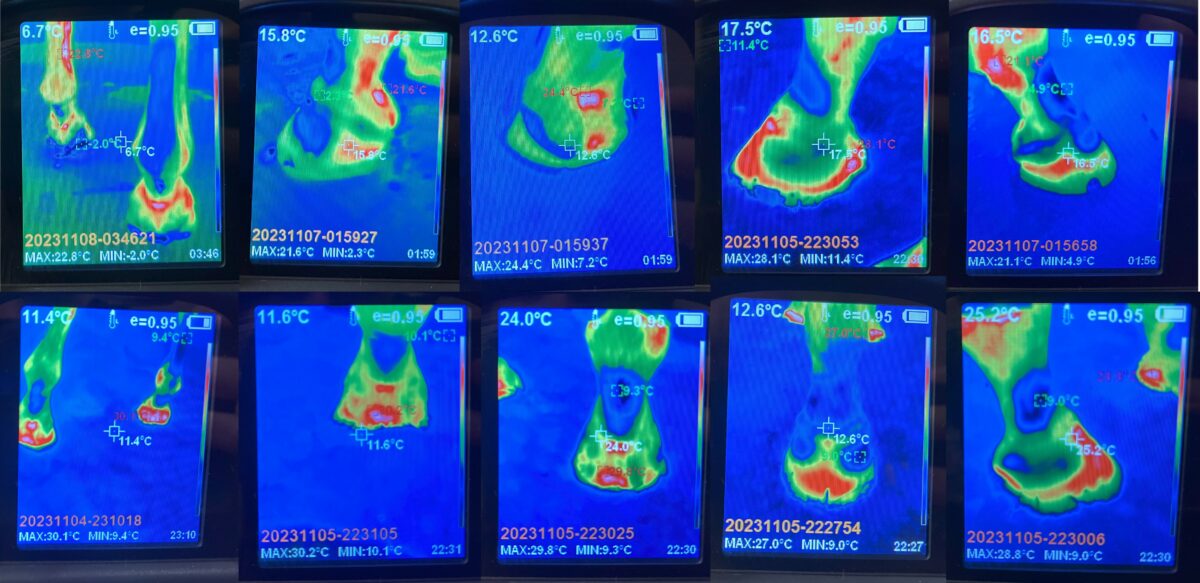
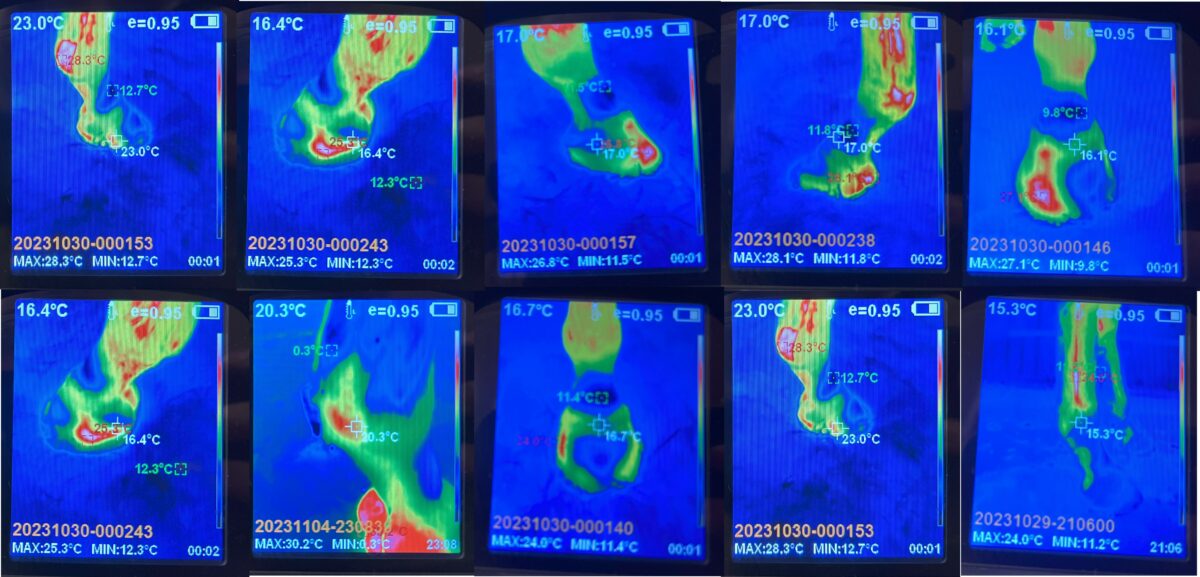
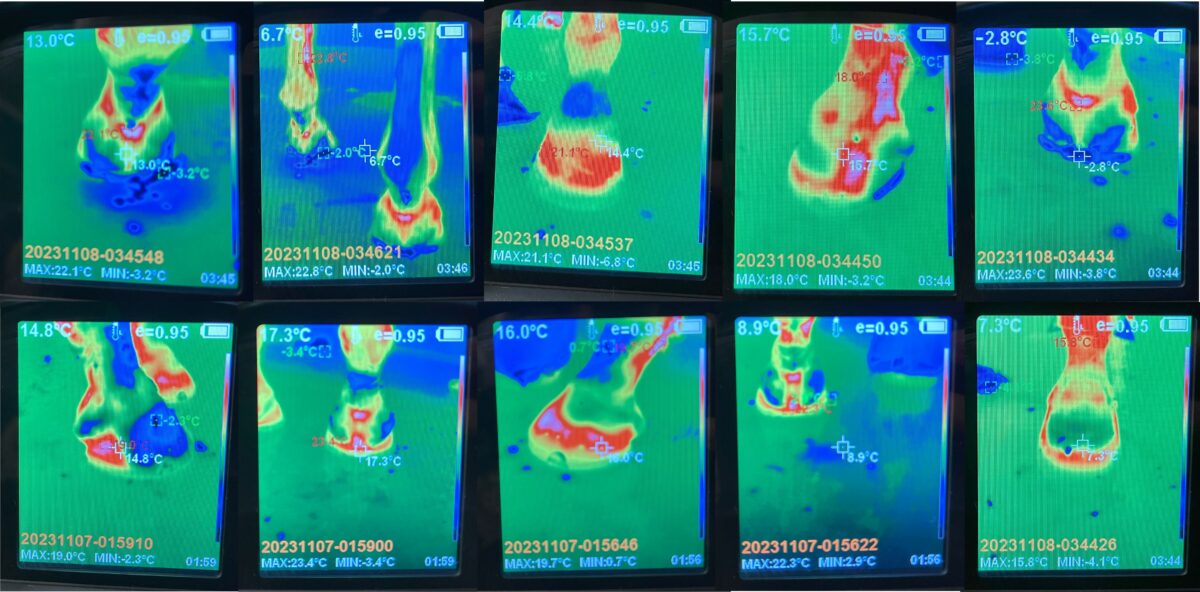
This was not satisfactory effect, so I continued the search and tried an approach that has been around much longer than ice boots. And the effect was very good indeed. After 20 min, the entire foot and half way up the cannon bone has been cooled. From the images below its almost hard to see the front feet as they are entirely blue while the hindlegs visible in the picture are obviously warm ‘warmer’.

The concept is very simple, add the leg to what looks like a wellington boot for horses, add water and ice then leave for 20 min. There is a pump that can be used, but I found it to be effective without the pump. These boots are called Jack’s Whirlpool boots which I got from LeMieux.
If you are interested in getting a thermal image camera for yourself, they are widely available and perhaps cheaper than what many would think. I got mine on Amazon.
